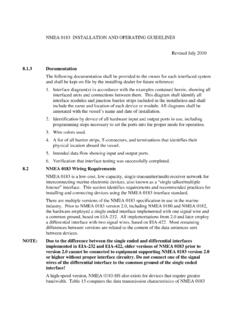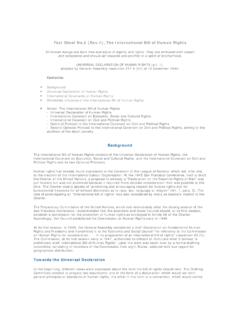Transcription of U.S. Department Of Homeland Security
1 Department Of Homeland Security RECORD OF CHANGES CHANGE NUMBER DATE OF CHANGE DATE ENTERED BY WHOM ENTERED i CONTENTS LEGAL CONVERSION NAVIGATION PART A RULE 1 RULE 2 RULE 3 General PART B STEERING AND SAILING Section I Conduct of Vessels in Any Condition of RULE 4 RULE 5 RULE 6 Safe RULE 7 Risk of RULE 8 Action to Avoid RULE 9 Narrow RULE 10 Traffic Separation Section II Conduct of Vessels in Sight of One RULE 11 RULE 12 Sailing RULE 13 RULE 14 Head-on RULE 15 Crossing RULE 16 Action by Give-way RULE 17 Action by Stand-on RULE 18 Responsibilities Between Section III Conduct of Vessels in Restricted RULE 19 Conduct of Vessels in Restricted PART C LIGHTS AND RULE 20 RULE 21 RULE 22 Visibility of RULE 23 Power-driven Vessels RULE 24 Towing and RULE 25 Sailing Vessels Underway and Vessels Under RULE 26 Fishing RULE 27 Vessels Not Under Command or Restricted in Their Ability to ii RULE 28 Vessels Constrained by Their 29 Pilot RULE 30 Anchored Vessels and Vessels 31 PART D SOUND AND LIGHT RULE 32 RULE 33 Equipment for Sound
2 RULE 34 Maneuvering and Warning Signals ..116 RULE 35 Sound Signals in Restricted 36 Signals to Attract RULE 37 Distress PART E RULE 38 ANNEX I - Positioning and Technical Details of Lights and ANNEX II - Additional Signals for Fishing Vessels Fishing in Close ANNEX III - Technical Details of Sound Signal ANNEX IV - Distress ANNEX V (33 CFR 88) - Pilot INTERPRETATIVE COLREGS DEMARCATION PENALTY Violations of international Navigation Rules and Violations of Inland Navigation Rules and for Negligent Duties Related to Marine Casualty Assistance and Duty to Provide Assistance at ALTERNATIVE WATERS SPECIFIED BY THE VESSEL BRIDGE-TO-BRIDGE RADIOTELEPHONE 208 iii INTRODUCTION international Rules The international Rules in this book were formalized in the Convention on the international Regulations for Preventing Collisions at Sea, 1972, and became effective on July 15, 1977.
3 The Rules (commonly called 72 COLREGS) are part of the Convention, and vessels flying the flags of states ratifying the treaty are bound to the Rules. The United States has ratified this treaty and all United States flag vessels must adhere to these Rules where applicable. President Gerald R. Ford proclaimed 72 COLREGS and the Congress adopted them as the international Navigational Rules Act of 1977. The 72 COLREGS were developed by the Inter-Governmental Maritime Consultative Organization (IMCO) which in May 1982 was renamed the international Maritime Organization (IMO). In November 1981, IMO s Assembly adopted 55 amendments to the 72 COLREGS which became effective on June 1, 1983.
4 The IMO also adopted 9 more amendments which became effective on November 19, 1989. The international Rules in this book contain these amendments. These Rules are applicable on waters outside of established navigational lines of demarcation. The lines are called COLREGS Demarcation Lines and delineate those waters upon which mariners shall comply with the Inland and international Rules. COLREGS Demarcation Lines are contained in this book. iv INTRODUCTION CONTINUED Inland Rules The Inland Rules in this book replace the old Inland Rules, Western Rivers Rules, Great Lakes Rules, their respective pilot rules and interpretive rules, and parts of the Motorboat Act of 1940.
5 Many of the old navigation rules were originally enacted in the last century. Occasionally, provisions were added to cope with the increasing complexities of water transportation. Eventually, the navigation rules for United States inland waterways became such a confusing patchwork of requirements that in the 1960 s several attempts were made to revise and simplify them. These attempts were not successful. Following the signing of the Convention on the international Regulations for Preventing Collisions at Sea, 1972, a new effort was made to unify and update the various inland navigation rules.
6 This effort culminated in the enactment of the Inland Navigational Rules Act of 1980. This legislation sets out Rules 1 through 38 the main body of the Rules. The five Annexes were published as regulations. It is important to note that with the exception of Annex V to the Inland Rules, the international and Inland Rules and Annexes are very similar in both content and format. The effective date for the Inland Navigation Rules was December 24, 1981, except for the Great Lakes where the effective date was March 1, 1983. v LEGAL CITATIONS 72 COLREGS international Navigational Law 95 - 75; Act of Stat.
7 308; ..33 1601 - 1608 COLREGS Demarcation CFR 80 72 COLREGS: Implementing CFR 81 72 COLREGS: Interpretative CFR 82 Amendments to 72 COLREGS FR 28634 June 1, 1983 INLAND RULES Inland Navigational Rules Act of Law 96 - 591; ..94 Stat. 3415; ..33 2001 - 2038 Annex l: Positioning and Technical Details of Lights and CFR 84 Annex Il: Additional Signals for Fishing ..33 CFR 85 in Close Proximity Annex lIl: Technical Details of CFR 86 Signal Appliances Annex IV: Distress Signals ..33 CFR 87 Annex V: Pilot CFR 88 Inland Navigation Rules: Implementing CFR 89 Inland Navigation Rules: Interpretative Rules.
8 33 CFR 90 VESSEL BRIDGE-TO-BRIDGE RADIOTELEPHONE Vessel Bridge-to-Bridge Radiotelephone Law 92-63; ..85 ; ..33 1201 - 1208 Vessel Bridge-to-Bridge CFR 26 Regulations (Coast Guard regulations) Radiotelephone Stations Provided for Compliance With the Vessel Bridge-to Bridge Radiotelephone Act (Federal Communications Commission regulations) Other FCC regulations pertaining to vessel bridge-to-bridge radiotelephone communications are contained in various sections of 47 CFR 80..47 CFR - Boundary CFR 7 vi CONVERSION TABLE Conversion of Metric to Customary/Imperial Units Customary/ Imperial Measure Metric Measure (approx.)
9 1000 Meters (M) .. ft. 500 ft. 200 ft. 150 ft. 100 ft. 75 ft. 60 ft. 50 ft. 25 ft. 20 ft. 12 ft. 10 ft. 8 ft. 7 ft. 6 ft. 5 ft. ft. ft. ft. ft. ft. ft. 1 ft..9 in..6 in..5 in. 300 Millimeters (mm).. in. 200 in. vii NAVIGATION RULES international INLAND 1 international General PART A GENERAL RULE 1 Application (a) These Rules shall apply to all vessels upon the high seas and in all waters connected therewith navigable by seagoing vessels. (b) Nothing in these Rules shall interfere with the operation of special rules made by an appropriate authority for roadsteads, harbors, rivers, lakes or inland waterways connected with the high seas and navigable by seagoing vessels.
10 Such special rules shall conform as closely as possible to these Rules. (c) Nothing in these Rules shall interfere with the operation of any special rules made by the Government of any State with respect to additional station or signal lights, shapes or whistle signals for ships of war and vessels proceeding under convoy, with respect to additional station or signal lights or shapes for fishing vessels engaged in fishing as a fleet. These additional station or signal lights, shapes or whistle signals shall, so far as possible, be such that they cannot be mistaken for any light, shape or signal authorized elsewhere under these Rules1.







